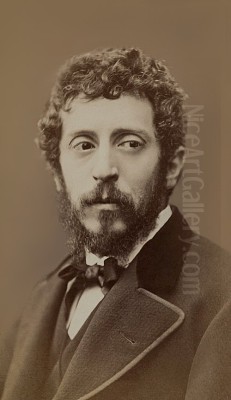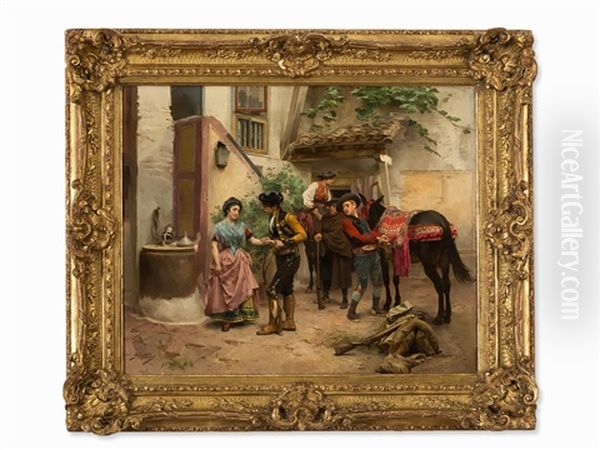
Jules Worms (1832-1924) stands as a significant figure in 19th-century French art, celebrated for his vivid and often humorous genre scenes, particularly those inspired by his extensive travels and deep appreciation for Spanish culture. Born in Paris, Worms emerged during a period when French visual satire was flourishing, an environment that undoubtedly shaped his keen observational skills and narrative approach to painting. His journey from an illustrator and printmaker to a highly respected painter, recognized in the Paris Salons and sought after by international collectors, marks a career defined by meticulous craftsmanship, a distinct thematic focus, and a charming engagement with the everyday lives of his subjects.
Early Life and Artistic Formation in Paris
Jules Worms was born in Paris on December 16, 1832. His formative years coincided with a dynamic era in French art and society. The July Monarchy and the subsequent Second Republic saw a burgeoning print culture, with illustrated journals and satirical caricatures gaining widespread popularity. Artists like Honoré Daumier and Paul Gavarni were household names, their work providing sharp, witty commentary on contemporary life. This atmosphere likely instilled in the young Worms an early appreciation for narrative art and the power of visual storytelling.
His formal artistic training began in 1849 when he entered the prestigious École des Beaux-Arts in Paris. This institution was the bedrock of academic art in France, emphasizing classical principles, drawing from life, and the study of Old Masters. While the specific masters under whom Worms studied are not always prominently highlighted, the rigorous training at the École would have provided him with a strong foundation in anatomy, perspective, and composition. During this period, he initially focused on illustration and printmaking, skills that would serve him well throughout his career, honing his ability to create clear, expressive, and detailed imagery. His early professional life was dedicated to providing illustrations for various publications, a common path for many aspiring artists of the time.
The Allure of Spain: A Defining Influence

A pivotal turn in Worms' artistic trajectory came with his developing fascination for Spain. In the 1860s, he began making trips to the Iberian Peninsula, often in the company of fellow artists. One of his significant associates during this period was the Spanish painter Eduardo Zamacois y Zabala (1841-1871), a rising star known for his small-scale, highly finished genre scenes, often with a touch of humor or historical romanticism. Worms and Zamacois, along with the French painter Jean-Georges Vibert (1840-1902), even shared a studio in Paris for a time, fostering an environment of mutual artistic exchange.
These journeys to Spain were transformative for Worms. He was captivated by the country's vibrant culture, its distinct regional customs, the picturesque landscapes, and the everyday life of its people. He immersed himself in studying Spanish art, drawing particular inspiration from two towering figures: Diego Velázquez (1599-1660) and Francisco Goya (1746-1828). From Velázquez, the master of Spanish Golden Age painting, Worms learned much about the sophisticated use of color, the realistic depiction of figures, and the ability to capture a sense of presence and dignity in his subjects. Goya, on the other hand, offered a model for incisive social commentary and satire, as well as a darker, more expressive approach to human psychology and societal critique. Worms skillfully synthesized these influences, adapting Velázquez's painterly qualities and Goya's satirical edge to his own unique vision. His numerous sketches and studies from these travels provided a rich repository of material for his paintings for years to come.
Artistic Style, Themes, and Techniques
Jules Worms is best known as a genre painter, an artist who specialized in scenes of everyday life. His canvases are typically populated with lively characters engaged in relatable, often anecdotal, situations. While he occasionally depicted French scenes, his most characteristic and celebrated works are those set in Spain. These paintings transport the viewer to sun-drenched plazas, rustic taverns, bustling marketplaces, and intimate domestic interiors.
His style is marked by a careful attention to detail, clear storytelling, and a vibrant color palette. He had a particular talent for capturing expressive gestures and facial expressions, bringing his characters to life and imbuing his scenes with a sense of immediacy and often, gentle humor. Worms' compositions are typically well-structured, guiding the viewer's eye through the narrative. He often employed a rich, warm tonality, reflecting the southern European light, and his rendering of textures—be it the coarse fabric of a peasant's garment, the gleam of a polished guitar, or the rough-hewn wood of a village inn—was highly accomplished.
The themes explored by Worms were diverse, yet consistently focused on human interaction and social customs. He depicted flirtatious encounters, musical gatherings, local politicians holding court, smugglers plying their trade, families at leisure, and moments of quiet contemplation. While often lighthearted, his works were underpinned by a keen observation of social dynamics and character types, occasionally hinting at a subtle critique or a deeper understanding of the human condition, reminiscent of the satirical spirit he admired in Goya. His paintings were not grand historical statements in the manner of Jacques-Louis David or Eugène Delacroix, nor were they avant-garde explorations like those of his Impressionist contemporaries such as Claude Monet or Edgar Degas. Instead, Worms carved a niche for himself with charming, accessible, and technically proficient scenes that appealed to a broad audience.
Notable Works and Salon Success
Worms made his debut at the prestigious Paris Salon in 1859, the official art exhibition of the Académie des Beaux-Arts. This was a critical venue for artists seeking recognition and patronage. His submissions were well-received, and he went on to achieve significant success at the Salon, winning medals in three consecutive years: 1867, 1868, and 1869. This consistent recognition solidified his reputation as a skilled and popular artist.
Among his many celebrated paintings, several stand out as representative of his oeuvre. "La Ronde" (The Round Dance), for instance, captures the joyous abandon of a village festival, with figures swirling in a traditional dance. "The Interrupted Siesta" might depict a humorous or charming moment of daily life. Works like "A Spanish Inn" or "The Politician in the Barber Shop" offer glimpses into social hubs, filled with character studies and narrative potential.
One particularly well-known work often cited is "The Smugglers Farewell" (or variations like "Departure of the Smugglers"). Such paintings tapped into the romantic fascination with figures operating outside the strictures of society, a theme popular in 19th-century art and literature. These scenes were often imbued with a sense of adventure and drama, showcasing Worms' ability to create compelling visual narratives with colorful characters and picturesque settings. Other titles that reflect his Spanish focus include "Fountain in Burgos," "A Spanish Kitchen," and "The Cautious Advance." His skill extended beyond oil painting; he was also an accomplished etcher and lithographer, producing prints that further disseminated his popular imagery.
Contemporaries, Collaborations, and Artistic Milieu
Jules Worms operated within a vibrant and diverse Parisian art world. His collaboration with Eduardo Zamacois y Zabala and Jean-Georges Vibert was significant. Zamacois, though his career was tragically short, was a leading figure among the Spanish artists in Paris and a friend of Marià Fortuny (1838-1874), another highly influential Spanish painter known for his dazzling technique and Orientalist and genre scenes. Fortuny's international success helped popularize Spanish themes among collectors. Vibert, like Worms, specialized in genre scenes, often with a humorous or anecdotal quality, though he frequently depicted cardinals and other ecclesiastics in luxurious settings.
The academic tradition, upheld by the École des Beaux-Arts, was dominated by figures like Jean-Léon Gérôme (1824-1904), Alexandre Cabanel (1823-1889), and William-Adolphe Bouguereau (1825-1905). While Worms shared their commitment to technical skill and finish, his subject matter was generally less grandiose and more focused on intimate, everyday scenes. He can also be seen in relation to other French genre painters of the era, such as Ernest Meissonier (1815-1891), who was renowned for his meticulously detailed historical and military genre scenes, albeit on a often smaller scale.
The broader artistic landscape of the latter half of the 19th century also saw the rise of Realism, championed by Gustave Courbet (1819-1877), and later, Impressionism, which radically challenged academic conventions. While Worms did not align himself with these avant-garde movements, his work, with its focus on contemporary life and its observational acuity, can be seen as part of a wider interest in depicting the modern world, albeit through a more traditional stylistic lens. His dedication to Spanish themes also connected him to a broader 19th-century European fascination with Spain, often viewed through a romantic and exoticizing lens by artists and writers from other countries.
Recognition, Patronage, and Legacy
Jules Worms' appealing subject matter, combined with his artistic skill, brought him considerable success not only in France but also internationally, particularly in the United States. American collectors, developing a taste for European art, were drawn to his lively and accessible Spanish scenes. By the 1880s, his works had entered prominent American collections.
Among his notable patrons were John Wolfe and his daughter, Catharine Lorillard Wolfe. Catharine Lorillard Wolfe (1828-1887) was a significant art collector and philanthropist who bequeathed her extensive collection, including works by Worms, to the Metropolitan Museum of Art in New York. This bequest was instrumental in establishing the Met's collection of European paintings. Another American collector who acquired Worms' work was James H. Stearns. The presence of his paintings in such esteemed collections underscores his contemporary appeal and the high regard in which his art was held.
Jules Worms continued to paint and exhibit throughout his long career. He passed away in Paris on November 25, 1924, at the venerable age of 92. He left behind a substantial body of work that continues to be appreciated for its charm, technical finesse, and its affectionate portrayal of Spanish life. While perhaps not a revolutionary innovator in the mold of the Impressionists, Worms was a master of his chosen genre, creating a distinctive artistic identity that resonated with the tastes of his time.
His legacy lies in his contribution to 19th-century genre painting and in his role as a cultural bridge, bringing the color and vibrancy of Spanish life to a wider European and American audience. His paintings offer a window into a bygone era, rendered with a skill and warmth that ensures their enduring appeal. They are testaments to an artist who found his deepest inspiration in the people and customs of a foreign land, translating his observations into works of art that continue to delight viewers today. His dedication to narrative clarity, combined with a subtle humor and a rich palette, secured his place as a beloved chronicler of everyday life.